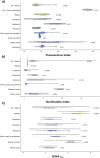Inferring Ecosystem Function from Dissolved Organic Matter Optical Properties: A Critical Review
- PMID: 35917372
- PMCID: PMC9387109
- DOI: 10.1021/acs.est.2c04240
Inferring Ecosystem Function from Dissolved Organic Matter Optical Properties: A Critical Review
Abstract
Over the last 30 years, the optical property community has shifted from conducting dissolved organic matter (DOM) measurements on new complex mixtures in natural and engineered systems to furthering ecosystem understanding in the context of past, present, and future carbon (C) cycling regimes. However, the appropriate use of optical properties to understand DOM behavior in complex biogeochemical systems is of recent debate. This critical review provides an extensive survey of DOM optical property literature across atmospheric, marine, and terrestrial biospheres using a categorical approach that probes each biosphere and its subdivisions. Using this approach, a rubric of ecosystem variables, such as productive nature, C cycling rate, C inputs, and water quality, sets the foundation for interpreting commonly used optical property DOM metrics such as fluorescence index (FI), humification index (HIX), and specific ultraviolet absorbance at 254 nm (SUVA254). Case studies and a meta-analysis of each biosphere and subdivision found substantial overlap and characteristic distributions corresponding to ecosystem context for FI, HIX, and SUVA254, signifying chromophores and fluorophores from different ecosystems may be more similar than originally thought. This review challenges researchers to consider ecosystem connectivity when applying optical property results rather than making traditional "if this, then that" results-style conclusions.
Keywords: Absorbance; DOM; atmospheric; carbon quality; chromophores; fluorescence; fluorophores; marine; reactivity; source material; spectroscopy; terrestrial.
Conflict of interest statement
The authors declare no competing financial interest.
Figures






References
-
- Coble P. G.; Green S. A.; Blough N. V.; Gagosian R. B. Characterization of dissolved organic matter in the Black Sea by fluorescence spectroscopy. Nature 1990, 348, 432–435. 10.1038/348432a0. - DOI
-
- Prairie Y. T. Carbocentric limnology: looking back, looking forward. Canadian Journal of Fisheries and Aquatic Sciences 2008, 65 (3), 543–548. 10.1139/f08-011. - DOI
-
- Perdue E. M.; Ritchie J. D. Dissolved Organic Matter in Fresh Waters. Treatise on Geochemistry 2003, 5, 1–46. 10.1016/B0-08-043751-6/05080-5. - DOI
-
- Thurman E. M.Organic geochemistry of natural waters; Martinus Nijhoff/Dr. W. Junk Dordrecht: The Netherlands, 1985;10.1007/978-94-009-5095-5. - DOI
Publication types
MeSH terms
Substances
LinkOut - more resources
Full Text Sources
Miscellaneous

